What is AAM Updates Notifier and Should You Disable It
Some users have been reaching us with questions after noticing that an executable named AAM Updates Notifier is either crashing regularly or it’s taking up a lot of system resources. Users are wondering whether the file is legitimate and if they should take the appropriate steps to prevent the file from running. Other users are reporting that they get a startup error involving AAM Updates Notifier.exe at every system startup.
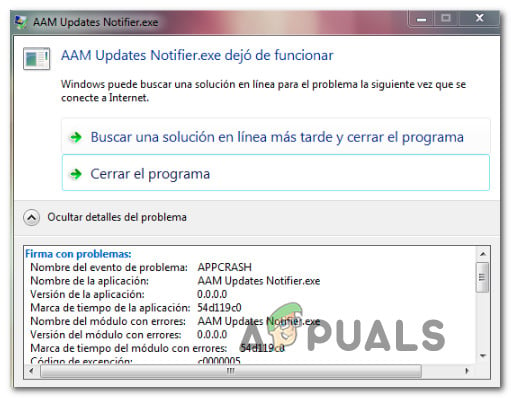
As it turns out, AAM Update Notifier.exe is not exclusive to the Windows platform since we also found user reports on it appearing on Mac computers.
What is AAM Updates Notifier?
Based on our investigations, the real AAM Updates Notifier.exe is a legitimate software component of most Adobe applications. Most commonly it’s encountered in relation with Adobe Acrobat and other associated programs that are used to create, view modify and print PDF (Portable Document Format) files. AAM Updates Notifier stands for Adobe Application Manager Updates Notifier.
What this process essentially does is it informs the user (via the system tray) that a new update is available for Adobe Acrobat or a similar program developed by Adobe.
The default location of the AAM Updates Notifier.exe file is: C:\Program Files (x86)\Common Files\Adobe\OOBE\PDApp\UWA\
Is AAM Updates Notifier a security threat?
Based on our investigations, the chance of dealing with an infected AAM Update Notifier.exe file are very slim. However, there are certain malware applications that are known to camouflage as trusted processes in order to avoid detection.
To ensure that you’re not dealing with a malware in disguise, we encourage you to update the file to VirusTotal for analysis and see if the file is actually infected. This service will cross-check the file against 70 different virus databases to determine whether the file is malicious or not. Here’s a quick guide on how to do this:
- First things first, verify the location of the file. To do this, press Ctrl + Shift + Esc to open up a Task Manager window.
- Once you get there, select the Processes tab and scroll down to the list of Background processes. Then, scroll through the list of background processes and locate AAM Updates Notifier Application
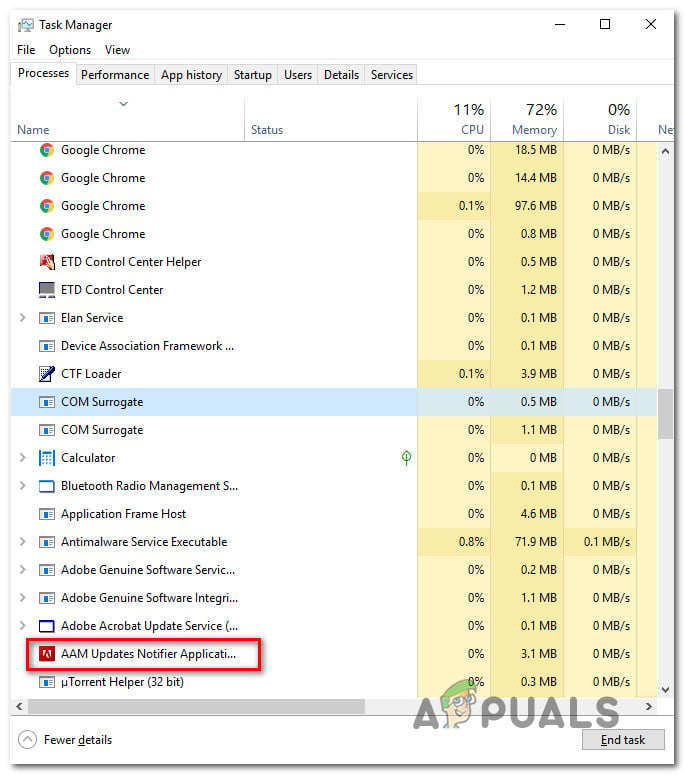
- Next, right-click on AAM Updates Notifier Application and click on Open File Location from the context menu.
- If the action takes you to a location different than the one below, chance’s are you’re dealing with a malicious file:
C:\Program Files (x86)\Common Files\Adobe\OOBE\PDApp\UWA\
- In case the revealed location is suspicious, visit this link (here), click on Choose File and upload the AAM Updates Notifier.exe file.
- Wait until the analysis is complete, then see if any engines have detected the file as being malicious. If the number of engines that flagged the file as being malicious is under 15, you can determine that you’re dealing with a false positive and the file is not actually infected.
However, if the scan reveals that the file is infected, you need to deal with it as soon as possible before the infection spreads. The quickest and most efficient way to do this is to use a reliable security scanner that removes the infection completely. If this scenario is applicable to you, we recommend using Malwarebytes to perform a deep scan and remove the infection along with any leftover files.
If you’re unfamiliar with the process of installing & using Malwarebytes to remove malware, you can follow this article (here).
How to Fix AAM Updates Notifier errors
If you’re seeing frequent crashes involving the AAM Updates Notifier.exe file, chances are the issue is caused by your Creative Suite version. We investigated this particular issue by looking at various user reports and the repair strategies that are commonly being used to fix this particular problem.
As it turns out, there are several different culprits that have the potential of causing issues with the AAM Updates Notifier.exe:
- Corrupted AAM Update Notifier executable – As it turns out, this particular issue can occur in situations where the AAM Update Notifier.exe file is tainted by corruption and stops functioning correctly. In situations like these, some affected users have reported that the issue was resolved after they deleted AAM updater and AAMupdater from several locations and then reinstalled Adobe Application Manager.
- Corrupted Creative Suite Installation – It’s also possible that the problem is actually being caused by a corrupted Creative Suite installation. If this scenario is applicable, you will be able to resolve the issue by either repairing the installation or uninstalling it and then reinstalling the latest version.
- 3rd party AV conflict – Certain 3rd party security suites are known to be overprotective and prevent AAM Update Notifier from communication with Adobe servers. If this scenario is applicable, you should be able to resolve the issue by disabling the real-time protection of your AV or switching to a more permissive security suite.
- AAM Updater scheduled task keeps calling the executable – Older Adobe installations will include a potentially annoying task that is scheduled to wake AAM Update Notifier every day. If the executable is corrupted or is missing some dependencies, this could end up producing daily errors. In this case, you should be able to resolve the issue by disabling the task using Task Scheduler.
- Adobe Acrobat Update Service is causing the problem – If the Adobe Acrobat Update Service is scheduled to start automatically, it will also call upon the AAM Update Notifier. If you want to ensure that the executable is not being called, you can set the status of Adobe Acrobat Update Service to disabled.
If you’re currently encountering an error related to the AAM Updates Notifier.exe file, this article will provide you with several potential repair strategies.
Down below, you’ll find a collection of methods that other users in a similar scenario have successfully used to fix the problem. Follow whichever method is applicable to your situation to fix errors related to AAM Updates Notifier.exe.
Method 1: Reinstalling or Repairing Adobe Creative Suite
If you’re encountering an error message related with the AAM Update Notifier application at every system startup, chances are the issue is being caused by your Creative Suite installation.
Note: If you don’t have Creative Suite, move down to the next method below.
Several other affected users have reported that the error was no longer occurring after they reinstalled or repaired the Creative Suite that the AAM Updates Notifier.exe file belonged to.
Here’s a quick guide on reinstalling or repairing your Creative Suite version on Windows computers:
- Press Windows key + R to open up a Run dialog box. Then, type “appwiz.cpl” and press Enter to open up the Programs and Features window.

Type appwiz.cpl and Press Enter to Open Installed Programs List - Inside Programs and Features, scroll through the list of installed applications and locate your Creative Suite installation.
- Once you see it, right-click on it and choose Repair at the prompt. Then, follow the rest of the on-screen prompts to complete the reparation process.

Repairing the Creative Suite installation - Restart your computer and see if the issue has been resolved once the next startup sequence is complete.
- If the same issue is still occurring follow the first 3 steps again, but once you get to the confirmation prompt click on Uninstall instead.
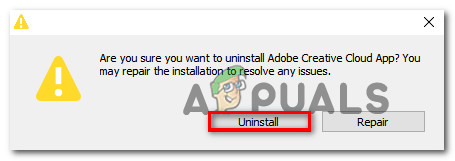
Uninstalling Adobe Creative Suite - Follow the on-screen instructions to complete the uninstallation. Once the process is complete, restart your computer.
- After the next startup sequence is complete, visit this link (here), sign in with your account and re-download the latest version of Adobe Creative cloud according to your payment plan.
- Follow the on-screen instructions to complete the installation of Adobe Creative Cloud and see if the issue has been resolved.
If the same issue is still occurring, move down to the next method below.
Method 2: Deleting AAM updater
If you’re seeing the “AAM Updates Notifier Application has stopped working” error (or something similar), it’s very likely that the issue is actually being caused by a corrupted AAM Updates Notifier Application.
Several users encountering the very same issue have reported that they managed to resolve the issue by systematically tracking down and deleting any instances of Adobe Application Manager, AAM Updater and AAMUpdaterInventory from every possible directory.
Here’s a quick guide on how to rid your computer of Adobe Application Manager, AAM Updater and AAMUpdaterInventory and reinstall Adobe application Manager:
- Open the File Explorer, navigate to the following location and delete any folders named Adobe Application Manager, AAM Updater or AAMUpdaterInventory:
C:\Program Files (x86)\Common Files\Adobe
- From the same File Explorer window, Navigate to the following location and delete AAMUpdater:
C:\ProgramData\Adobe
Note: Inside File Explorer, go to the View tab (from the ribbon bar at the top) and make sure that the box associated with Hidden Items is Enabled.
- Press Windows key + R to open up a Run dialog box. Then, type “%APPDATA%” and press Enter to open the hidden AppData folder.
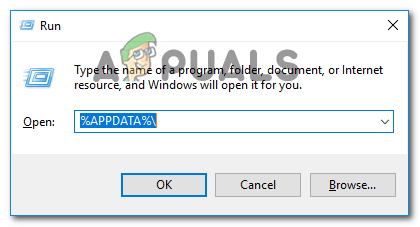
Opening the hidden AppData folder via a Run dialog box - Once you get there, navigate to Local > Adobe and delete AAMUpdater.
- Restart your computer.
- When the next startup sequence is complete, visit this link (here) and click on Proceed to Download. After you do this, you’ll be taken to the download page of the latest Adobe Application Manager version. Once you get there, click on Download Now to initiate the download.
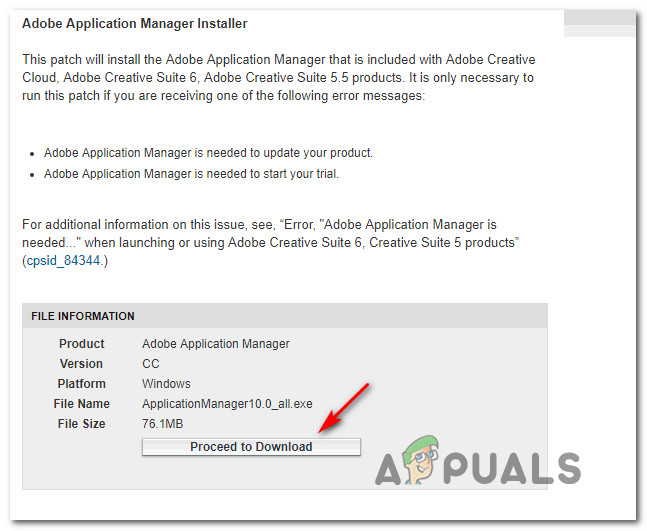
Downloading Adobe Application Manager - Once the installation executable is downloaded, open it and follow the on-screen prompts to complete the installation.
- Restart your computer once again and see if the issue has been resolved once the next startup sequence is complete.
If you’re still encountering issues with the AAM Updates Notifier Application, move down to the next method below.
Method 3: Disabling the real-time protection of your 3rd party AV (if applicable)
If the first two methods haven’t worked for you, chances are you’re using an overprotective antivirus suite that is preventing the AAM Updates Notifier from communicating with outside servers. If this scenario is applicable, you might be able to resolve the issue by temporarily disabling the real-time protection of your security suite.
Of course, the steps of doing so are specific to each 3rd party security suite. But typically, you can do this directly by right-clicking the tray bar icon of the AV and disabling the real-time protection (shield) via the context menu.

Note: If you can’t find how to disable the real-time protection of your AV, search online for specific instructions online
Additionally, you can also consider uninstalling your 3rd party AV and make the switch to the default security suite Windows Security (formerly known as Windows Devender). If you decide to go this route, you can follow this article (here) for steps on how to remove your current security suite without leaving any leftover files that could still produce effects.
If this method is not applicable or you’re still encountering issues with AAM Updates Notifier Application even after disabling your 3rd party AV, move down to the next method below.
Method 4: Disabling the task related to AAM Updater
If none of the potential solutions above have helped you to resolve the issues caused by the AAM Updater, there’s one procedure that will ensure you’ll not going to get an AMM Updater related error ever again. Several affected users have reported that they managed to get rid of the annoying AAM Updates Notifier errors by using Task Scheduler to delete the task that ultimately calls the executable at fixed intervals.
But keep in mind that this method will not resolve the underlying cause that is producing the error. It’s simply a workaround that will stop AAM Updater from running. Expect to lose some functionality related to the automatic update of some Adobe products.
Here’s a quick guide on doing this:
- Press Windows key + R to open up a Run dialog box. Then, type “taskschd.msc” and press Enter to open the up Task Scheduler utility.

Type taskschd.msc in the Run to open Task Scheduler - Once you’re inside Task Scheduler, select Task Scheduler Library from the vertical menu on the left section of the screen, then move over to the right pane and double-click on Adobe AAMUpdater.

Disabling the AAMUpdater task using Task Scheduler - Right-click on the AdobeAAMUpdater task and choose Disable from the context menu.
- Close Task Scheduler, restart your computer and see if the error stops occurring starting with the next system startup.
If the same issue is still occurring, move down to the next method below.
Method 5: Disabling the Adobe Acrobat Update Service
If none of the methods above, you should be able to stop any further errors related to AAM Updates Notifier by ensuring that the Adobe Acrobat Update Service is prevented from running. But as you might imagine, expect to lose the automatic update functionality of all your Adobe products. But that shouldn’t be a problem if you remember to update manually on a regular basis.
Here’s a quick guide on disabling the Adobe Acrobat Update service:
- Press Windows key + R to open up a Run dialog box. Then, type “services.msc” and press Enter to open up the Services screen.

Running Services - Once you’re inside the Services screen, scroll down through the list of services and locate Adobe Acrobat Update Service.
- Once you see it, right-click on it and choose Properties from the context menu.

Accessing the properties screen of Adobe Acrobat Update Service - Inside the Properties screen of Adobe Acrobat Update Service Properties, select the General tab and change the Startup type to Disabled using the drop-down menu.

Setting the Startup Type of Adobe Acrobat Update Service to Disabled - Close the services screen, restart your computer and see if the issue is now resolved (once the next startup sequence is complete).




